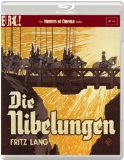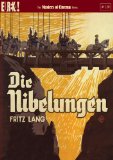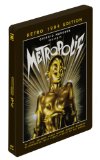 DIE NIBELUNGEN (Masters of Cinema) (BLU-RAY) | Blu Ray | (29/10/2012)
from £14.79
| Saving you £3.20 (21.64%)
| RRP
DIE NIBELUNGEN (Masters of Cinema) (BLU-RAY) | Blu Ray | (29/10/2012)
from £14.79
| Saving you £3.20 (21.64%)
| RRP Perhaps the most stately of Fritz Lang's two-part epics, the five-hour Die Nibelungen is a courageous and hallucinatory work. Its extraordinary set-pieces, archetypal themes, and unrestrained ambition have proved an inspiration for nearly every fantasy cycle that has emerged on-screen since - from Star Wars to The Lord of the Rings.In Part One, Siegfried, the film's eponymous hero acquires the power of invincibility after slaying a dragon and bathing in the creature's blood. Later, an alliance through marriage between the hero and the royal clan of the Nibelungen turns treacherous, with Siegfried's sole weakness exploited. In Part Two, Kriemhilds Rache [Kriemhild's Revenge], Siegfried's widow travels to the remote land of the Huns to wed the monstrous Attila, and thereby enlist his forces in an act of vengeance that culminates in massacre, conflagration, and, under the auspices of Lang, one of the most exhilarating and terrifying end-sequences in all of cinema.Adapted from the myth that was also the basis for Wagner's Ring cycle of operas, Lang's epic offers its own startling expressionistic power - a summit of the director's artistry. The Masters of Cinema Series is proud to present Die Nibelungen in a spectacular new HD restoration.
![Metropolis [1926]](/pictures/1013374.jpg) Metropolis | DVD | (27/01/2003)
from £N/A
| Saving you £N/A (N/A%)
| RRP
Metropolis | DVD | (27/01/2003)
from £N/A
| Saving you £N/A (N/A%)
| RRP Fritz Lang's Expressionistic masterwork continues to exert its influence today, from Chaplin's Modern Times (1936) to Dr Strangelove (1963), and into the late 1990s with Dark City (1998). In the stratified society of the future (Y2K no less), the son of a capitalist discovers the atrocious conditions of the factory slaves, falling in love with the charismatic Maria in the bargain, who preaches nonviolence to the workers. But even the benevolent leadership of Maria is a challenge to the privileged class, so they have the mad-scientist Rotwang concoct a robot double to take her place and incite the workers to riot. The story is melodrama, but it's the powerful imagery that is so memorable. One of the most arresting images has legions of cowed workers filing listlessly into the great maw of the all-consuming machine-god Moloch. Unfortunately, the print used for this DVD is unfocused, scratchy, and five minutes short, altogether unworthy of a visionary masterpiece. It may be too much to hope for the complete film to be restored (only two hours of the original three-hour film are extant), but a clean transfer from a fine-grain negative ought to be possible. And why, when there are other possible future Metropolises to be had, should we downtrodden masses accept this junk? --Jim Gay
 DIE NIBELUNGEN (Masters of Cinema) (DVD) | DVD | (29/10/2012)
from £11.98
| Saving you £10.00 (100.10%)
| RRP
DIE NIBELUNGEN (Masters of Cinema) (DVD) | DVD | (29/10/2012)
from £11.98
| Saving you £10.00 (100.10%)
| RRP Perhaps the most stately of Fritz Lang's two-part epics, the five-hour Die Nibelungen is a courageous and hallucinatory work. Its extraordinary set-pieces, archetypal themes, and unrestrained ambition have proved an inspiration for nearly every fantasy cycle that has emerged on-screen since - from Star Wars to The Lord of the Rings.In Part One, Siegfried, the film's eponymous hero acquires the power of invincibility after slaying a dragon and bathing in the creature's blood. Later, an alliance through marriage between the hero and the royal clan of the Nibelungen turns treacherous, with Siegfried's sole weakness exploited. In Part Two, Kriemhilds Rache [Kriemhild's Revenge], Siegfried's widow travels to the remote land of the Huns to wed the monstrous Attila, and thereby enlist his forces in an act of vengeance that culminates in massacre, conflagration, and, under the auspices of Lang, one of the most exhilarating and terrifying end-sequences in all of cinema.Adapted from the myth that was also the basis for Wagner's Ring cycle of operas, Lang's epic offers its own startling expressionistic power - a summit of the director's artistry. The Masters of Cinema Series is proud to present Die Nibelungen in a spectacular new HD restoration.
![Metropolis -- Two Disc Special Edition [1927]](/pictures/1012629.jpg) Metropolis -- Two Disc Special Edition | DVD | (27/01/2003)
from £N/A
| Saving you £N/A (N/A%)
| RRP
Metropolis -- Two Disc Special Edition | DVD | (27/01/2003)
from £N/A
| Saving you £N/A (N/A%)
| RRP If you think you know Fritz Lang's Metropolis backwards, this special edition will come as a revelation. Shortly after its premiere, the expensive epic--originally well over two hours--was pulled from distribution and re-edited against Lang's wishes, and this truncated, simplified form is what we have known ever since 1926. Though not quite as fully restored as the strapline claims, this 118-minute version is the closest we are likely to get to Lang's original vision, complete with tactful linking titles to fill in the scenes that are irretrievably missing. Not only does this version add many scenes unseen for decades, but it restores their order in the original version. Until now, Metropolis has usually been rated as a spectacular but simplistic science fiction film, but this version reveals that the futuristic setting is not so much prophetic as mythical, with elements of 1920s architecture, industry, design and politics mingled with the mediaeval and the Biblical to produce images of striking strangeness: a futuristic robot burned at the stake, a steel-handed mad scientist who is also a 15th Century alchemist, the trudging workers of a vast factory plodding into the jaws of a machine that is also the ancient God Moloch. Gustav Frohlich's performance as the hero who represents the heart is still wildly overdone, but Rudolf Klein-Rogge's engineer Rotwang, Alfred Abel's Master of Metropolis and, especially, Brigitte Helm in the dual role of saintly saviour and metal femme fatale are astonishing. By restoring a great deal of story delving into the mixed motivations of the characters, the wild plot now makes more sense, and we can see that it is as much a twisted family drama as epic of repression, revolution and reconciliation. A masterpiece, and an essential purchase. On the DVD: Metropolis has been saddled with all manner of scores over the years, ranging from jazz through electronica to prog-rock, but here it is sensibly accompanied by the orchestral music Gottfried Huppertz wrote for it in the first place. An enormous amount of work has been done with damaged or incomplete elements to spruce the image up digitally, and so even the scenes that were in the film all along shine with a wealth of new detail and afford a far greater appreciation for the brilliance of art direction, special effects and Helm's clockwork sexbomb. A commentary written but not delivered by historian Ennio Patalas covers the symbolism of the film and annotates its images, but the production information is left to a measured but unchallenging 45-minute documentary on the second disc (little is made of the astounding parallel between the screen story in which Klein-Rogge's character tries to destroy the city because the Master stole his wife and the fact that Lang married the actor's wife Thea von Harbou, authoress of the Metropolis novel and screenplay!). There are galleries of production photographs and sketches; biographies of all the principals; and an illustrated lecture on the restoration process which uses before and after clips to reveal just how huge a task has been accomplished in this important work. --Kim Newman
 Giorgio Moroder Presents: METROPOLIS (LIMITED EDITION DVD STEELBOOK) | DVD | (23/07/2012)
from £29.99
| Saving you £-10.00 (N/A%)
| RRP
Giorgio Moroder Presents: METROPOLIS (LIMITED EDITION DVD STEELBOOK) | DVD | (23/07/2012)
from £29.99
| Saving you £-10.00 (N/A%)
| RRP In the era when one could still but only dream of a comprehensive restoration of Fritz Lang's silent sci-fi epic Metropolis, esteemed pop artist/producer and pioneering electronic composer Giorgio Moroder followed his work on Brian De Palma's cult-classic Al Pacino vehicle Scarface by assembling his own version of Lang's 1920s classic. The result was a zeitgeist-infused, high-kitsch/high-art amalgam of some of the quintessential cinema images and then-contemporary 1980s pop-chart melodrama. For millions around the world, it is this version of Metropolis – featuring music by Moroder himself and artistes such as Adam Ant, Pat Benatar, Freddie Mercury, Bonnie Tyler, and Jon Anderson – which first comes to mind whenever mention is made of the Lang original or, indeed, the iconic imagery and power of silent cinema.

Please wait. Loading...
This site uses cookies.
More details in our privacy policy